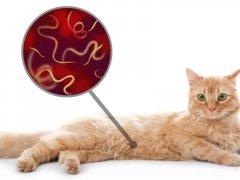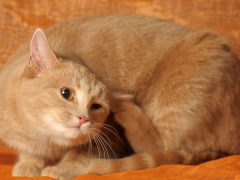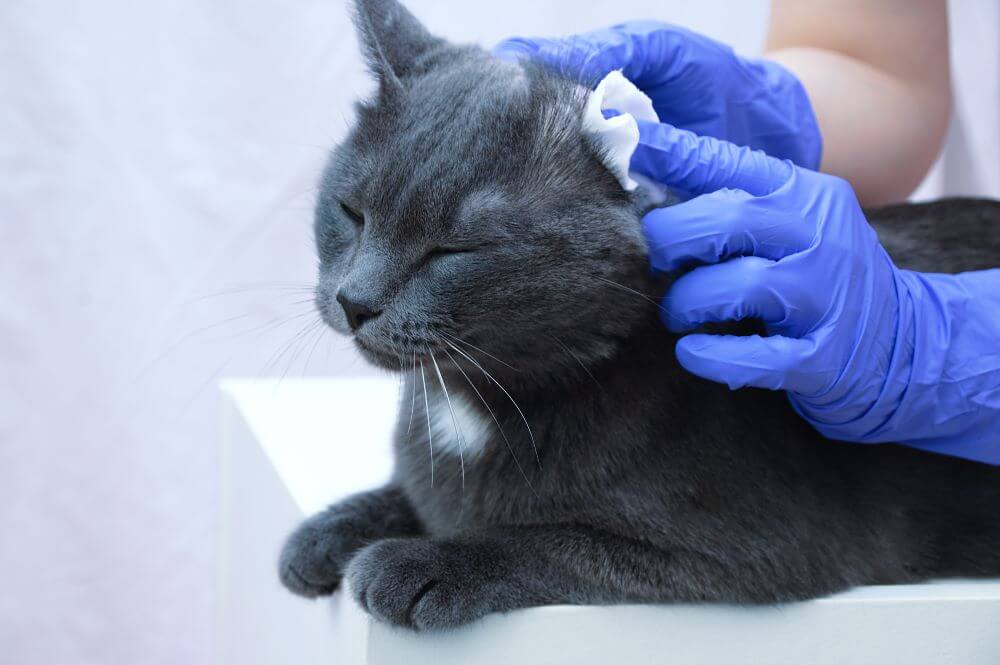
In this article, you’ll find out how cats get ear mites, learn about the signs of an ear mite infection, and get details on how to eradicate an infestation.
What Are Ear Mites in Cats?
Ear mites are microscopic parasites that usually take up residence in your cat’s ear canals, although the mites can spread to other parts of the body, including the neck, rear end, and tail area.
In the ear, the mites feed on your cat’s ear wax, skin flakes, and oils. The most common species of ear mite affecting cats and dogs is Otodectes cynotis. Ear mites are especially common in kittens, although cats of any age can contract ear mites. Although dogs can be affected by ear mites too, they are much more commonly seen in cats.
How Do Cats Get Ear Mites?
Ear mites are extremely contagious in cats, passing from animal to animal. Kittens often get ear mites from their mothers. Adult cats can pick up ear mites from other cats and even from dogs since the same type of ear mite affects many different species.
Outdoor cats are more likely to become infested with ear mites since they come in contact with other animals. Wild animals like raccoons and foxes can transmit ear mites to cats. Indoor cats, although at less risk, may develop ear mites if they are exposed to a cat or dog carrying the parasite.
Signs and Symptoms of Ear Mites in Cats
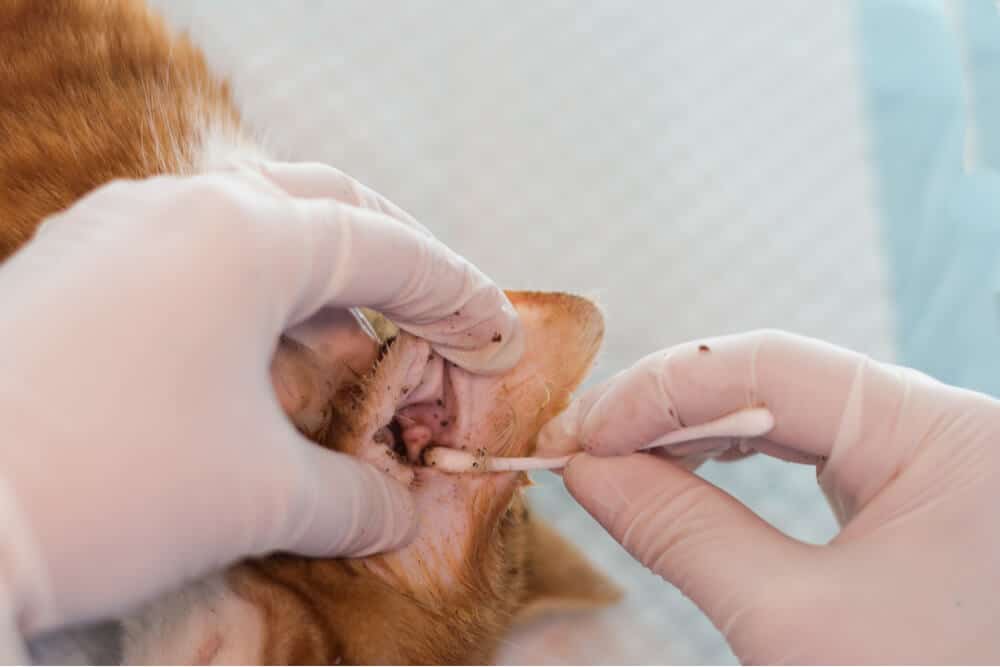
While ear mites themselves are almost invisible to the naked eye, cats with ear mites exhibit a distinctive discharge that often resembles coffee grounds.
While ear mites themselves are almost invisible to the naked eye, cats with ear mites exhibit a distinctive discharge. This discharge may be an early clue that you should have your veterinarian check your cat or kitten for ear mites.
Ear mite infestations have a characteristic dark, thick, smelly “ear gunk,” which consists of ear wax and debris. This debris contains live mites, dead mites, mite eggs, and dried blood. This brown, grainy discharge often resembles coffee grounds.
Some bacterial or yeast ear infections produce similar discharge, so confirmation of the presence of ear mites by your cat’s veterinarian is important for proper treatment. Your veterinarian will use a microscope to positively identify the mites.
If you’re curious, you can Google “pictures of ear mites in cats” for some images of cats with ear mites. Fair warning: ear mite infestations in cats are not pretty!
Ear mite infestations are extremely uncomfortable for your cat. The mites cause severe itching and pain. Some cats with severe, chronic infestations can even develop weight loss or neurologic symptoms.
Symptoms of ear mite infestation in cats include:
- Copious dark, bad-smelling debris in the ear
- Crusty or scabby ears
- Red, inflamed ears
- Bumps in the ears
- Scratching at the ears
- Head shaking
- Scratches and bleeding around the ears (self-inflicted)
- Hair loss
- Itching and scabbing on the neck, rear end, and tail areas
- Head tilt
- Aural hematoma (swelling of the ear flap due to a ruptured blood vessel)
Cat Ear Mites vs. Earwax (Dirty Cat Ears)
How do you know if your cat has ear mites or just a buildup of earwax?
Healthy cat ears are not typically dirty. Cats might sometimes develop a small amount of earwax, which can be easily wiped away with a cotton ball soaked in a pet-safe ear cleaner.
If you see large amounts of dark, sticky, bad-smelling debris in your cat’s ear, or if the ear looks red and inflamed, it is likely something more than simple ear wax.
Cat Ear Mites vs. Yeast Or Bacterial Infection
Although ear mite infestations are the most common cause of ear irritation seen in cats, it’s possible for your cat to develop a yeast or bacterial infection in her ears. It can be difficult to differentiate between an ear mite infestation and a yeast or bacterial ear infection.
The symptoms of an ear mite infestation and other types of ear infections are very similar—scratching at the ears, shaking the head, and a buildup of debris in the ears. Also, cats can have both an ear mite infestation and a bacterial and/or yeast ear infection at the same time, so microscopic examination of any ear discharge by a veterinarian helps assure appropriate treatment.
Ear Mite Treatment For Cats
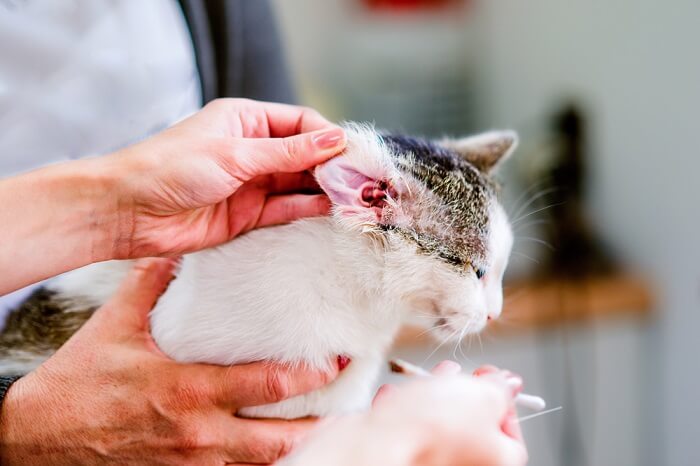
It’s important to bring your cat to the veterinarian if she exhibits any ear problems. Left untreated, an ear mite infestation can cause serious damage to the cat’s ear canal, especially if the cat develops a secondary bacterial infection.
Untreated ear infections are not only very painful, but they can cause hearing loss and balance problems due to loss of equilibrium. Your vet will do a full physical exam and look into your cat’s ears with an instrument called an otoscope.
The veterinarian will also collect a sample of the ear debris with a swab to be looked at under a microscope to determine the root cause of the problem and what treatment is needed.
Steps for Successful Treatment of Ear Mites:
- Deep ear cleaning. Your veterinarian will clean the ears very carefully and thoroughly to remove as much wax and debris as possible. This step is important so that the medication can do its job.
- Medication. Your veterinarian may prescribe one or more medications depending on whether your cat has only an ear mite infestation or if she also has a bacterial or yeast infection. Ear mite medicine for cats commonly comes in the form of ear drops or topical flea medication that you apply at home. Your vet might also recommend an oral medication to treat any open wounds that appear infected.
- Thorough house cleaning. Although the life cycle of ear mites takes place on a host animal, ear mites and mite eggs can survive on your cat’s bedding, the carpet, and furniture for a little while. Vacuum carpets and furniture and wash bedding (your cat’s and yours, if your cat sleeps with you) in hot water on the longest wash setting, then dry in the dryer. It’s a good idea to go through this process about once a week during your cat’s ear mite treatment so your cat does not become reinfected with newly hatched mites.
- Treating other pets in the household. Ear mites are extremely contagious between animals, passing easily between other cats and dogs living in the same household. Your vet might recommend that you bring your other pets in to check for ear mites so they can be treated as well.
- Follow-up exam. About a month after your cat begins treatment for ear mites, your veterinarian will have you return to the clinic for a follow-up exam to make sure the infestation has cleared. This step is vital to ensure all mites have been killed. If mites are found, your vet will recommend additional treatment.
Home Remedies for Ear Mites in Cats
It’s always best to consult with your veterinarian before attempting any home remedies for ear mites. If your cat has a ruptured eardrum due to an ear infection, placing any substance in the ear can be dangerous and result in permanent hearing loss.
The only way to make sure the eardrum is intact is for your veterinarian to look inside the ear with an otoscope.
After getting their vet’s blessing, some people may wish to try home remedies for ear mites in cats like coconut oil or mineral oil. Using an oil in the ear can loosen wax and debris so it can be removed, and it also suffocates the mites.
Just be careful that any oil you use is safe for cats. Some oils, especially essential oils, can be toxic to cats.
Important safety tip: Never stick anything down into your cat’s ear canal, not even a cotton swab. You could damage or even puncture your cat’s eardrum.
Only clean the outer portions of the ears, as far as you can see down. If your cat has debris deep in her ear canal, leave it to the professionals and bring her to your vet for a deep ear cleaning.
Ear mites are extremely common in cats, but with the right treatment, you can safely resolve your cat’s infestation.
By identifying your cat’s ear mite infestation and taking careful, well-informed action, you can relieve your cat of the pain and itching that comes with this common condition.
Also Read: 5 Best Ear Mite Treatments for Cats
